-
Multimedia for adult literacy
普通类 -
- 支持
- 批判
- 提问
- 解释
- 补充
- 删除
-
-
A Case for Computer-based Multimedia in Adult Literacy Classrooms
COMPUTER-BASED MULTIMEDIA TECHNOLOGY PROVIDES ADULT LITERACY LEARNERS with the opportunity to engage in learning experiences that not only advances their level of literacy, but also exposes them to the technological environment of their society.
-
Literacy Defined
The US National Literacy Act of 1991 defined literacy as “ an individual’s ability to read, write, and speak in English and compute and solve problems at levels of proficiency necessary to function on the job and in society, to achieve one’s goals, and to develop one’s knowledge and potentials.”
This encompasses a wide range of information-processing skills. The society for which adult literacy instruction is being targeted is one that employs extensive use of technology in everyday life, information rich, and focuses more on the “use” rather than the “acquisition” of information.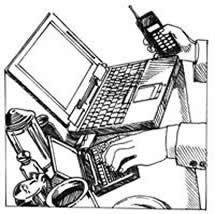
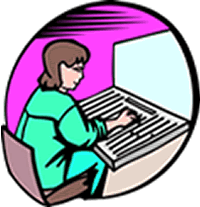
Computer-based technology exists in all
aspects of our daily livesThis article reviews the potential benefits of using computer-based multimedia technology with adult literacy learners in relation to their profile and needs.
-
Computer-based Multimedia Defined
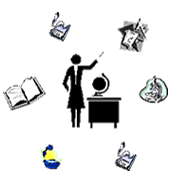
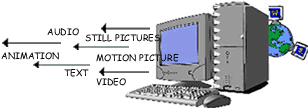
Teacher with different media tools Computer-based Multimedia tool
Good instructors have always been multimedia educators. However, once instructors went beyond large charts, globes and pull-down maps, multimedia became more costly, cumbersome, complicated and less reliable, as multiple machines were needed (Houghton, 2003).
Computer-based multimedia, two or more forms of communication delivered by one tool running different software, makes instructors’ access to multimedia more accessible and varied. When connected to the Internet, namely the Web -a digital, global multimedia library, the delivery of multimedia–based materials for instruction and learning, is further expanded.-
The Adult Literacy Learner - Profile and Needs
An instructors understanding of his/her students provides a platform for more effective instructional delivery. Knowles (1998) identified characteristics associated with the adult learner (Lieb,1991). Significant among these in relation to the adult literacy learner are:
•Autonomous and self- directed
•Having established values, beliefs and opinions
•Goal-oriented
•Practical and relevancy-oriented
Most adult literacy learners have family responsibilities
Other characteristics based on personal observation while working in this field over a four-year period are:
• Low level literacy (reading, writing, speaking and mathematics) skills
•Lacking in confidence and displaying a higher level of anxiety towards academic tasks than the typical adult learner
•Limited problem-solving and critical thinking skills (especially among lower level readers)
•Little or no computer-related skills
•Limited world knowledge and research skills
•Requiring an accelerated learning process
Many adult literacy learners have a history of academic frustration.
-
Linking the Benefits
The positive impact indicated by the majority of reports on studies involving computer-based multimedia and its effects on learning have been associated with other educational levels (Lehrer,_1993; Najjar,_1996; Reeves,_1998; Moursund_and_Smith,_1999 ; Houghton,_2003;). However, when the profile and needs of adult literacy learners are considered, these reports also indicate possible benefits for this group of students.
General benefits:
1. Providing alternative perspectives-A medium other than text provides the clarification the learners need.
• Learner: Low literacy levels
2. Higher interactivity- Learners becomes active participants rather than a passive observers.
• Learner: Low confidence and high anxiety/Established values, beliefs and opinions
3. Accelerated learning - Learners are able to complete a given set of educational objectives in less time than with more traditional approaches.
• Learner: Require accelerated learning process
4. More effective learning – Retention and application of knowledge is increased mainly as a result of the alternative perspectives and interactivity involved.
• Learner: Goal oriented / Autonomous and self-directed / Practical and relevancy-oriented
5. Acquire computer-related skills – Learners exposed to several ways of using the computer as a tool
• Learner: Little or no computer skills
Some Specific Benefits: (Place mouse over image for a definition of the product)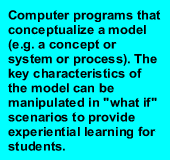
.jpg)
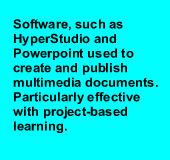
.jpg)
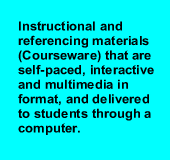

More Information:
The following are resources that instructors can use to gain skills in designing and implementing computer-based multimedia technology.
1) http://www.literacytech.org/
2) http://www.thestudyplace.org/welcome.taf
3) http://www.alri.org/harness.html-
Author
Andrea Shepard
Educational Technology Student
SDSU-
Bibliography
Bill, D. T. (1997). Popular Theory Supporting the Use of Computer Simulations for Experiential Learning. Retrieved November 29, 2003 from http://www.centurionsys.com/rtcl57.html
Bill, D. T. (1997). What is Interactive Multimedia CBT? Retrieved November 29, 2003 from http://www.centurionsys.com/rtcl61.html
Defining and Measuring Literacy (2003). National Assessment of Adult Literacy Report. Retrieved November 15, 2003 from http://nces.ed.gov/naal/defining/defining.asp
Houghton, R.S. (2003). Reports: Multimedia and Instruction in Education, version 5.03. Retrieved April 28, 2003 from www.ceap.wcu.edu/Houghton/MM/RationaleMM.html
Huss, S. (1990). Using Computers with Adult Literacy Learners. Eric Digest, Ed 343462. Retrieved November 22, 2003 from http://www.ericfacility.net/ericdigests/ed343462.html
Lehrer, R. (1993). Authors of Knowledge: Patterns of hypermedia design - Computers as Cognitive Tools. Hillsdale, NJ: Lawrence Eribaum.
Lieb, S. (1991). Principles of Adult Learning. VISION, Fall 1991. Retrieved November 23, 2003 from http://www.hcc.hawaii.edu/intranet/committees/FacDevCom/guidebk/teachtip/adults-2.htm
Models of Computer Use in Education (1997). Hypermedia in Education, Chapter 3.1.1. Retrieved November 29, 2003 from http://top.pefri.hr/mr/ch3_contents.htm
Moursund, D. and Smith, I. (2000). Research on Multimedia in Education. Retrieved November 15, 2003 from http://www.uoregon.edu/~moursund/dave/research2.htm
Najjar, L. J. (1996). Multimedia Information and Learning. Journal of Educational Multimedia and Hypermedia, 5(2), 129-150.
Reeves, T. C. (1998). the Impact of Media and Technology in Schools. Retrieved April 28,2003 from http://www.athensacademy.org/instruct/media_tech/reeves0.html
"Some images © 2003-(2003) http://www.clipart.com" -
-
- 标签:
- literacy
- skills
- multimedia
- computer-based
- 2003
- learners
- learner
- http
- retrieved
- adult
-
加入的知识群:



学习元评论 (0条)
聪明如你,不妨在这 发表你的看法与心得 ~